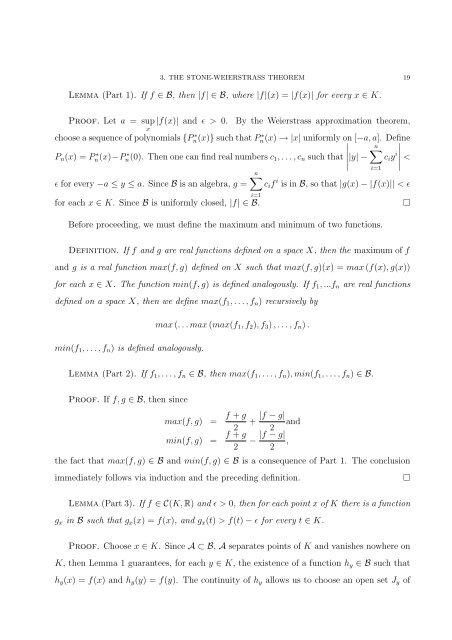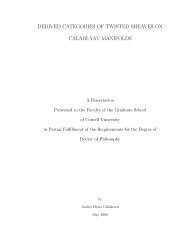FIVE MAJOR RESULTS IN ANALYSIS AND TOPOLOGY Aaron ...
FIVE MAJOR RESULTS IN ANALYSIS AND TOPOLOGY Aaron ...
FIVE MAJOR RESULTS IN ANALYSIS AND TOPOLOGY Aaron ...
You also want an ePaper? Increase the reach of your titles
YUMPU automatically turns print PDFs into web optimized ePapers that Google loves.
3. THE STONE-WEIERSTRASS THEOREM 19<br />
Lemma (Part 1). If f ∈ B, then |f| ∈ B, where |f|(x) = |f(x)| for every x ∈ K.<br />
Proof. Let a = sup |f(x)| and ǫ > 0. By the Weierstrass approximation theorem,<br />
x<br />
choose a sequence of polynomials {P ∗ n(x)} such that P ∗ n(x) → |x| uniformly on [−a,a]. Define<br />
Pn(x) = P ∗ n(x)−P ∗ n(0). Then one can find real numbers c1,...,cn such that<br />
ǫ for every −a ≤ y ≤ a. Since B is an algebra, g =<br />
<br />
n <br />
|y|<br />
− ciy<br />
<br />
i=1<br />
i<br />
<br />
<br />
<br />
<br />
<<br />
n<br />
cif i is in B, so that |g(x) − |f(x)|| < ǫ<br />
for each x ∈ K. Since B is uniformly closed, |f| ∈ B. <br />
Before proceeding, we must define the maximum and minimum of two functions.<br />
Definition. If f and g are real functions defined on a space X, then the maximum of f<br />
and g is a real function max(f,g) defined on X such that max(f,g)(x) = max (f(x),g(x))<br />
for each x ∈ X. The function min(f,g) is defined analogously. If f1,...fn are real functions<br />
defined on a space X, then we define max(f1,...,fn) recursively by<br />
min(f1,...,fn) is defined analogously.<br />
i=1<br />
max (...max (max(f1,f2),f3),...,fn).<br />
Lemma (Part 2). If f1,...,fn ∈ B, then max(f1,...,fn),min(f1,...,fn) ∈ B.<br />
Proof. If f,g ∈ B, then since<br />
max(f,g) =<br />
min(f,g) =<br />
f + g<br />
2<br />
f + g<br />
2<br />
|f − g|<br />
+ and<br />
2<br />
|f − g|<br />
− ,<br />
2<br />
the fact that max(f,g) ∈ B and min(f,g) ∈ B is a consequence of Part 1. The conclusion<br />
immediately follows via induction and the preceding definition. <br />
Lemma (Part 3). If f ∈ C(K, R) and ǫ > 0, then for each point x of K there is a function<br />
gx in B such that gx(x) = f(x), and gx(t) > f(t) − ǫ for every t ∈ K.<br />
Proof. Choose x ∈ K. Since A ⊂ B, A separates points of K and vanishes nowhere on<br />
K, then Lemma 1 guarantees, for each y ∈ K, the existence of a function hy ∈ B such that<br />
hy(x) = f(x) and hy(y) = f(y). The continuity of hy allows us to choose an open set Jy of
















